| WORKSHOPS Links:
Painting Flowers - Mandy Southan
Colour Mixing - Mandy Southan
Decorative Effects - Leonard Thompson
Dyeing Devores - Caroline Munns
Silk Choker Necklace - Linda Graves
Wax Melting Pots - Jill Kennedy
Gutta Pro-liners - Isabella Whitworth
Javana Air Pen - Isabella Whitworth
Microwave Dyeing - Vera Dreyfuss
Painting Borders - Tessa Barnes
Ten Top Tips - Jill Kennedy
Transferring designs - Anon
Free-style landscapes - Marianne Nash
Painted Silk Poppy - Mandy Southan
Magic Lettering - Leonard Thompson
Painted Lilies - Mandy Southan
The Silk Road - Mandy Southan
Aspects of Design - Leonard Thompson
Selling your work - Ian Bowers
Japan: Textiles - Mandy Southan
|
|
JAPAN: A WORLD OF WONDERFUL TEXTILES - Mandy Southan
A silk-painter's dream come true.
My trip to Japan in October 2006 fulfilled a dream. For many years I have wanted to trace silk painting back to it's 'roots' in the far east. My plan was to research traditional and contemporary Japanese silk painting techniques which encompass two basic types of resist dyeing - paste resist, which includes stencil dyeing, and shaped resist or shibori. Many kimono designs include a variety of such techniques in the same garment. |
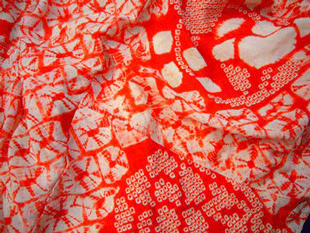 |
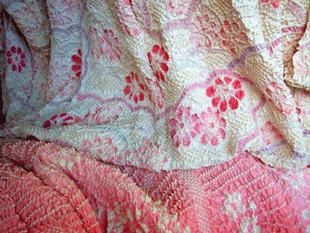 |
| Old shibori |
Old shibori |
| My careful planning and research prior to the trip paid off. It is actually very difficult indeed to find places in Japanese cities without speaking and reading the language and it is very tiring tramping the long and unbelievably crowded streets looking for a gallery or shop in a country which is utterly confusing and unfamiliar. You need a good map and a well planned itinerary for each day to make the most of your trip and avoid total exhaustion! |
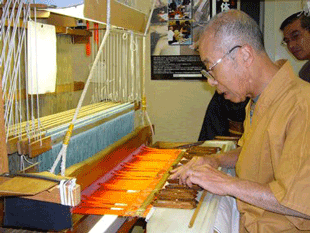 |
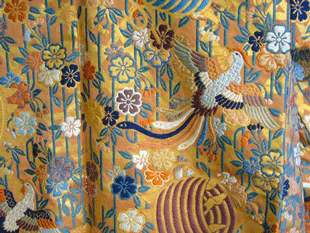 |
| Kyoto Nishijin weaver |
Nishijin weaving |
| We spent our first week in Tokyo - vast, noisy and frenetic, with a superb train service however, which made it easy to travel to places of interest in and around the city. Our second week was in Kyoto, the heart of the kimono making industry for many centuries and still the major textile centre of Japan. There are still many traditional weaving and dyeing workshops to be found in Kyoto and a number of world renowned contemporary Japanese textile artists have their studios there. Most of the stitching and binding work for shibori is done in Arimatsu, near Nagoya, and is sent to Kyoto to be dyed. I was told that there are very few people left now who produce the traditional shibori work - it is so labour intensive. Just a few old ladies retain the skills. |
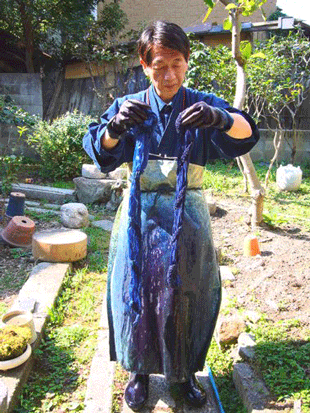 |
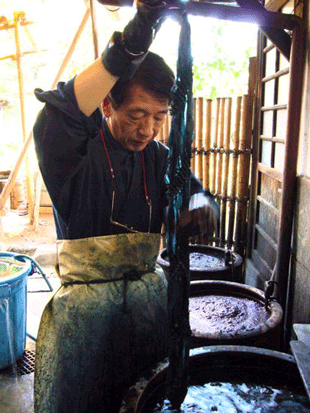 |
| Kyoto Indigo dyer |
Dipping the Silk in the Indigo Vat |
| Interspersed with trips to incredible temples and shrines and contemplative sojourns in Zen gardens, I visited numerous museums and galleries to look at kimono exhibitions and textile collections. I went to textile centres and workshops to watch demonstrations of traditional techniques, wandered around the vast, glittering department stores to look at displays of contemporary kimono and sought out obscure silk painting suppliers to buy traditional equipment to take home. I also 'talked' to as many people as I could (using sign language and my few Japanese words describing silk painting techniques) to discover as much as I could about traditional silk painting methods. It was fascinating and often highly amusing! |
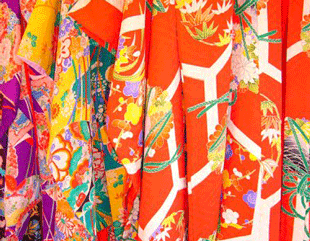 |
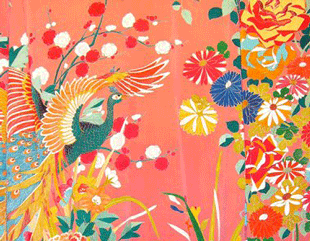 |
| Vintage Kimono for sale |
Peacock Kimono |
| The flea markets are good places to find old textiles.You find rails full of gorgeous brilliantly coloured vintage kimono for sale, fluttering in the breeze like exotic butterflies. I discovered some beautiful pieces of old shibori work in the market at Kitano Shrine in Kyoto. I bought a very worn kimono minus its sleeves, because the red shibori work was so striking. I also found a marvellous scrunchy ivory silk haori jacket with a delicious texture created by dense shibori patterning and hand painted flowers. Most of the remaining shibori work still produced in Kyoto is Kanoko shibori - resist -dyed rings. Patterns are created by binding thousands of minute circles, leaving spaces between the dots to create the design. I found a shop in Shijo-Dori, selling silk obi (kimono sashes) in jewel-like colours. They were so finely and intricately patterned I had to rummage in my bag for my strongest reading glasses to even see the dots! |
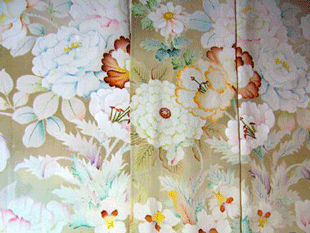 |
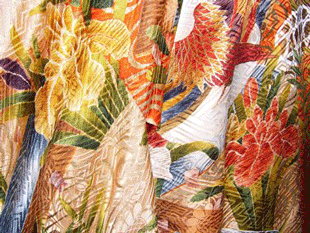 |
| Bokashi shading |
Iris Kimono (painted on figured* silk) |
Old silk kimono are often stencilled and hand painted, and although the majority of modern ones are now printed, you can still find some exquisite hand painted kimono in classy shops in Kyoto. Yuzen dyeing is the equivalent of our western gutta technique. The Japanese use a rice paste called nori. Traditionally, this is applied through a squeeze cone called a tsu-tsu, made from paper treated with persimmon tannin. It is soaked until it is soft, then filled with nori paste. The resist lines extruded from the nozzle are extraordinarily fine, yet seem to contain the dyes perfectly! Nori paste may also be stencilled onto the cloth using a tool like a small squeegee. The stencils are very finely cut and punched and allow for repeat patterns to be made. Areas of the design are then painted using the delicate shading technique called bokashi. Before new colours can be added, the rice paste is removed by soaking. Traditionally this was done in one of the two rivers that run through Kyoto. Entire sections of the design are then masked with the rice paste before the background is dyed. Very highly skilled and time-consuming work!
When artificial dyes were introduced to Japan in the 1860's, Yuzen flowered into a vibrant and highly sophisticated art form. Many traditional motifs are depicted in design work such as the crane ( symbolizing fidelity in marriage, good fortune and longevity), the peony (symbolizing nobility) and the iris (for purification and believed to ward off both plague and demons). *Figured silk is woven with a design.
A number of contemporary textile artists use wax resist or rozome. I was lucky enough to see an exhibition of Kimono using rozome techniques at the Fureikan Museum in Kyoto. The skill of Japanese silk painters is absolutely amazing. Their pursuit of perfection combined with total command of technique creates work of the highest quality.
I would have been very interested to discover more about art school training in Japan. I know it is very rigorous and disciplined and certainly produces artists with exceptional insight and skill. I think art schools in the U.K. would benefit greatly from studying the Japanese approach to teaching art, where mastery of technique is an essential factor in the production of a work of art.
Contemporary Japanese textile art is highly innovative and refined. There is an extraordinary attention to detail and a willingness on the part of the artist to devote huge amounts of time in making a piece of work. A piece of work simply takes as long as it takes. For myself, trained as a designer in the West, time-scale is always an essential consideration in a design brief. Time is money we are taught. I can't help feeling quality is often sacrificed! |
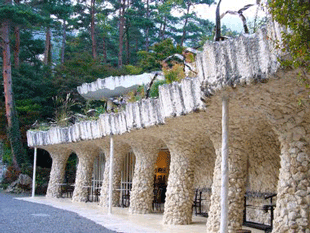 |
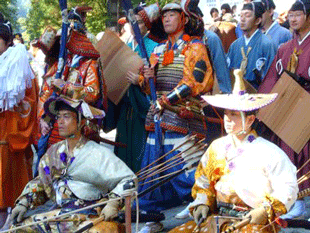 |
| Itchiku Kubota Museum |
Yabusame - Japanese mounted archers |
| Quality is never compromised in the work of Itchiku Kubota, who died only a few years ago and who produced, in my opinion, some of the greatest textile art ever made. His painted silk kimono are absolutely staggering! They are housed in a wonderful 'organic' building near mount Fuji, designed by Kubota himself to house his life's work and inspired by his visit to see Gaudi's architecture in Barcelona. On arriving we were greeted by several delightful attendants who bowed to us and led us into the main gallery. As I stepped in and saw these kimono, I could at first only stand and gasp with incredulity. The attendants looked on with curiosity and amusement as I then moved from piece to piece uttering strangled cries of amazement and excitement! I made copious notes and tried to fix the beauty of each piece in my mind. When I was finally ushered out after 5 hours, when the gallery was closing, the attendants bowed and presented me with a handful of pine cones from Itchiku Kubota's garden! A fitting souvenir for an eccentric English woman! |
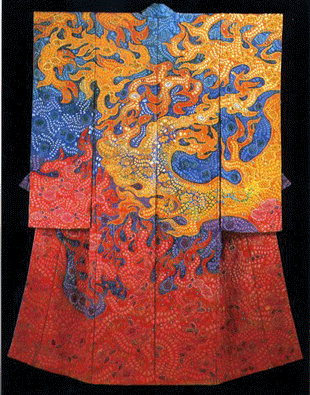 |
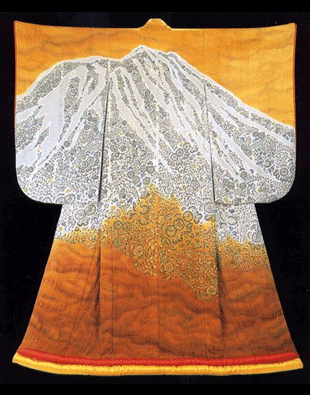 |
| Itchiku Tsujigahana |
Itchiku Tsujigahana |
| So what is so special about Kubota's work? Well firstly, the colours are unbelieveable. He hand painted and dip-dyed over and over again to build up harmonies of incredible subtlety and richness. He revived an ancient shibori technique called tsujigahana and developed it using modern dyes and methods. It basically involves brush painting the outline design onto the tacked together kimono and adding intricate sumi ink paintings, then stitching and binding miniscule portions of the silk, dyeing them by hand then binding them with plastic (capping) to protect them before further colours are applied. Entire backgrounds are textured with minute running stitches, so that the silk retains a 3 dimensional quality after steaming, and details are embroidered with shiny silk, to further accentuate the design. In addition, he used heavy, figured silks woven in beautiful natural patterns and often shot with gold so that the entire kimono glitters. Each kimono took many, many months to complete and each is a meditation on beauty. |
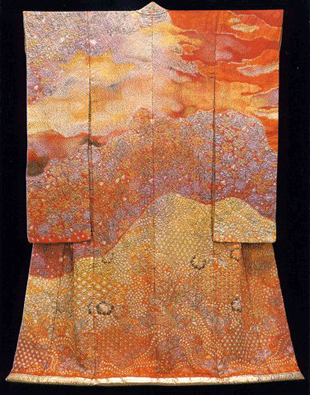 |
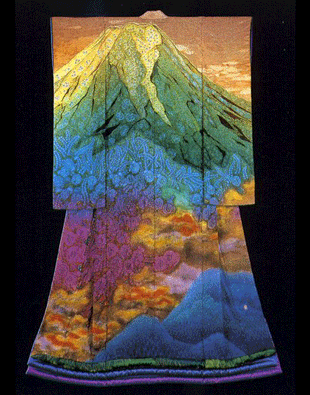 |
| Itchiku Tsujigahana |
Itchiku Tsujigahana |
| He painted his beloved mount Fuji in all lights and seasons to make a symphony of light and colour. Each kimono is a complete painting in it's own right yet is also part of a sequence in which the landscape changes through the seasons. So trees gradually change through autumn colours, snow comes to the mountains and the light changes through every concievable harmony, from the pearly opalescence of early morning to the rich, firey hues of the setting sun. I came away feeling totally inspired and also reassured that my own struggle, to try to capture beauty in nature and create beautiful textiles, is worthwhile. What was doubly reassuring was that Itchiku Kubota only started his life's work when he was 60! There's time for me yet! |
| |
|
| |
|
| |
|
|

